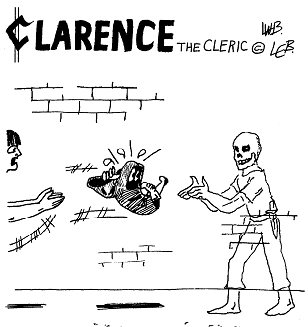Lords of Darkness
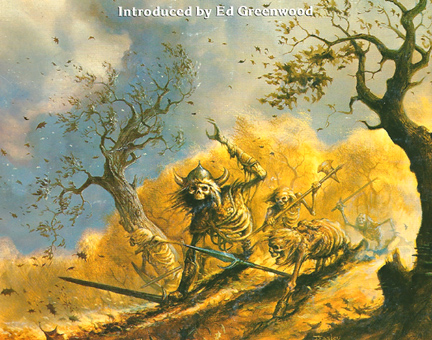
-
Lords of Darkness

-
UNDEAD
Undead share the following characteristics:
* They never check morale and are
immune to fear (except that clerics and paladins may cause a fear-like
effect by turning them, see Chapter III);
* they are immune to sleep,
charm and hold-type effects except for such effects that are specific to
undead (for example, if the GM chooses to house-rule a magic item or spell
which has the effect hold undead, this would work);
* they suffer 2d4 damage from vials of
holy
water; and
if damaged--for "injured" is the wrong
word--they do not automatically heal, though certain undead types such
as ghouls may be able to recover HP by consuming living flesh and others
such as spectres may do so through leeching a living creature's vital force
(draining a level).
- OSRIC.239
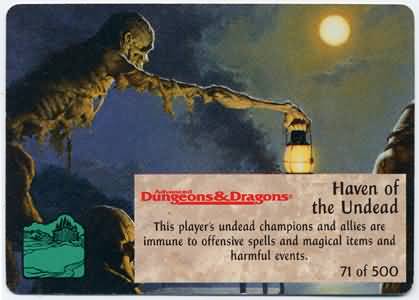
876 Undead (terrain: mountains, TPL30: 5th) (REF3.10)
<if there is a charm undead spell, then
add this: psionic encounter:
25% >
<same for detect
spells, as well>
Q: Undead, as a general class
of monsters,
are immune to sleep, charm,
and hold spells. Does this
immunity
also extend to web spells?
A: In general, no. Any creature
with a
corporeal body can be ensnared
by a web
unless it possesses some
special form of
protection, such as a ring
of free action.
Of course, incorporeal undead
such as
wraiths, spectres, groaning
spirits, ghosts,
and vampires in gaseous form
are immune
to webs.
(138.12)
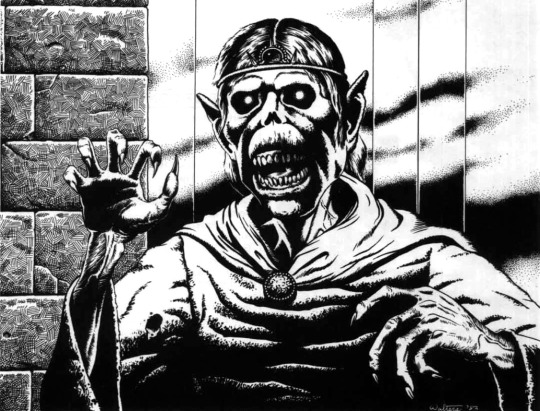
Q: Can normal persons speak
with
undead?
A: Unintelligent undead do
not converse;
they simply attack living
things. The more
powerful, intelligent, corporeal
undead
such as vampires and liches
do speak.
Whether or not other undead
speak is up
to the DM. In general, undead
are malevolent
beings who hate life and
are not
prone to talk. However, having
an undead
monster speak for dramatic
effect is perfectly
acceptable.
(138.12)
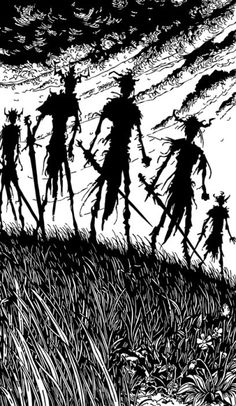
Q: Which creatures can become
undead? Is it possible to
have vampiric
purple worms or spectral
trolls? Or is undead status
limited to
humans and demi-humans? If
so,
what happens to other creatures
who are slain by ?undead-creating?
undead?
A: Some DMs rule that only
humans
become undead, but it is
more common to
include all the PC races
and their NPC
subraces. Animals and monsters
never
become undead unless their
remains are
magically animated as skeletons
or zombies.
Such creatures simply die
when slain
by undead.
(138.12)
Q: What happens when an undead
with a link to the NMP
is plane shifted to an outer
plane?
Would this sever the link?
A: Plane shift has no special
effect on
undead. If the spell succeeds,
that portion
of the undead that was formerly
on the
Prime Material is shifted
to the destination
plane; the link to the Negative
Material
remains intact. It is quite
possible that the
residents of the destination
plane will
resent having an undead monster
dumped
into their midst.
(138.12)
Q: Can psionically aware creatures
attack intelligent undead
with
attack mode A, assuming that
they
meet the requirements for
using
this attack on nonpsionic
beings?
Can intelligent undead be
dominated?
I assume the undead immunity
to charm prevents this.
A: There is no reason why
any undead that
is capable of independent
thought should
not be subject to psionic
attack, including
domination (this is not charm,
per se).
Mindless undead, such as
skeletons, are
immune to psionic attacks.
Individual DMs
might choose to rule that
all undead are
immune to psionic attacks
unless they
themselves use psionics.
(138.12)
Q: Can undead be psionic,
assuming
that the creature in question
was
psionic in life?
A: Only those undead which
can retain
character abilities, such
as vampires and
liches, can retain psionic
abilities in their
undead states.
(138.12)
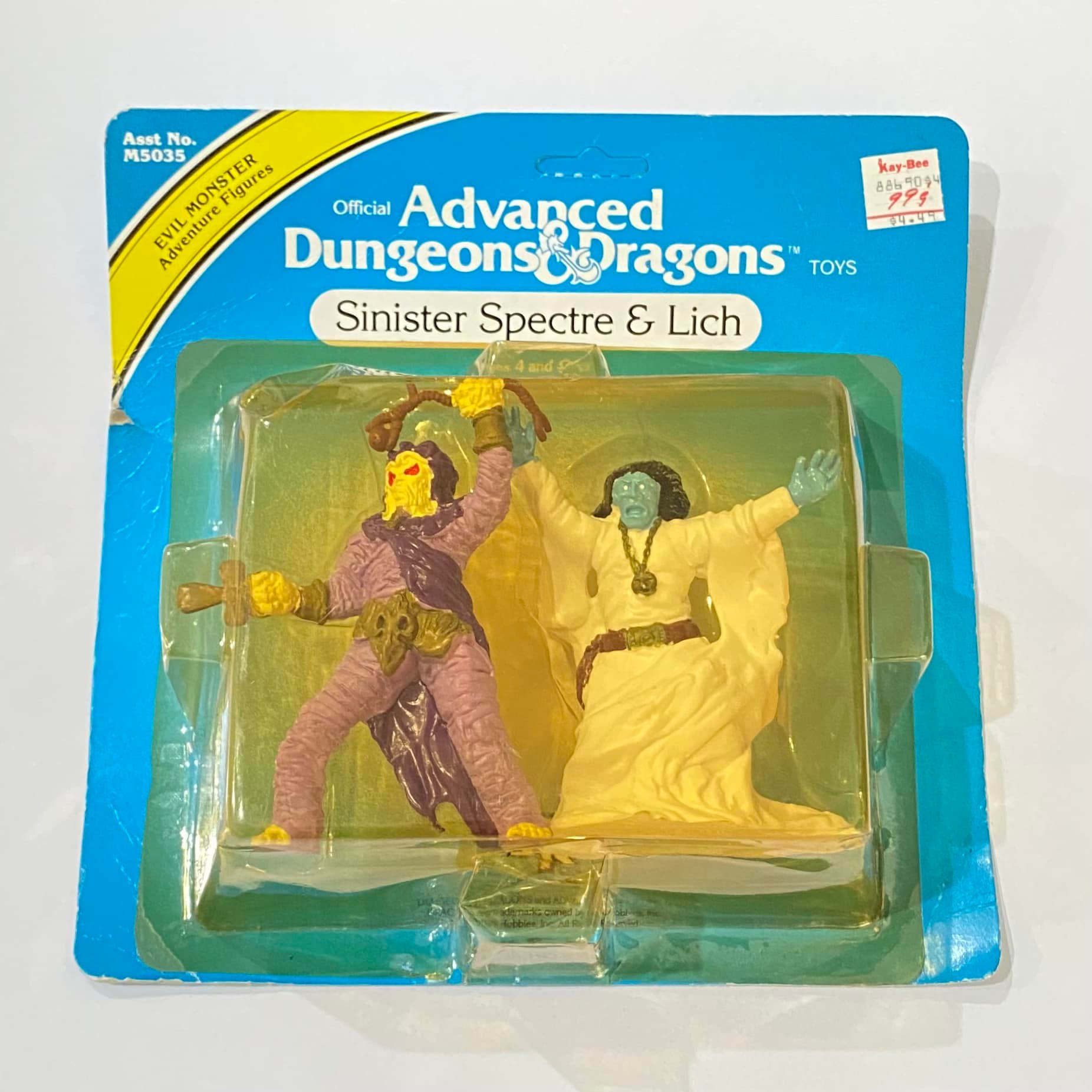
Q: Are wights, wraiths, mummies,
vampires, and spectres affected
by
magic missiles, lightning,
and magical
fire?
A: See the individual monster
descriptions
for each creature?s immunities;
note that
all undead are immune to
charms, holds,
paralyzation, sleep, and
poison. Any attack
which is not prohibited is
allowable.
(138.12)


Place in Spells
Dragon #252
Place in Spells
Dragon #252
Intellect Syringe (Dragon #252)
Undead: Immune to sleep and
charm. (ghast)
"They are, of course, immune
to charm, cold, death magic, hold, and sleep" (animal skeleton)
Due to its undead
status, vampires <grammar>
cannot be harmed by poison,
or charm,
sleep, and hold-type magics.
(vampire, REF5)
"All forms of undead, as well as creatures from the lower planes (demons, devils, night hags, nightmares, nycadaemons, etc.) are affected by HOLY WATER." (holy water)
'Against the Undead'
'Against the Undead'
'Against the Undead'
'Against the Undead'
Question: Do undead breathe, and could they live on an airless world?
Answer: No, they don’t,
and yes, they could. This is an instance where
undead can and should be
considered different from “living”
creatures. Undead have a
“life” of a sort, but they are not “alive.”
Their bodies do not require
food, water and air to sustain them-
selves like ours do.
(Correction: Ghouls,
and possibly some other undead, do require 'food').
Question:
Are liches or vampires destroyed or damaged by sunlight or torchlight?
What other undead, if any,
are adversely affected by exposure to sunlight or some other bright light
source?
Answer: From the various
descriptions of the undead monsters in the
MM, it appears that
only the vampire, the spectre
and the wraith are adversely
affected by light — and even then,
the light must be actual
sunlight or at least a light source of
daylight-level intensity.
The light from a torch or a lantern, or a
Light
spell, or a small-scale “fire” spell such as Flame Arrow, is
not bright enough to be harmful.
The status of wights
is questionable; wraiths are said to be
“similar in nature to wights,”
and wraiths have no power in full
sunlight, but wights are
only said to “hate sunlight,” leaving
unanswered the question of
whether they are harmed by it. The
sage recommends that wights
be treated differently from
wraiths, because the wight
is a weaker type of undead with less
of a “link” to the negative
material plane than the wraith, and it is
the wraith’s strong connection
to the eternal darkness of the
negative material plane that
makes the creature so vulnerable to
bright light.
All of the undead prefer to
lurk about in darkness. Ghosts and
shadows especially like places
where light does not shine, but
daylight doesn’t bother them
if they have to put up with it. A
lich’s hidden chambers are
“very dark,” says the MM, but ob-
viously the lich has powers
even in an illuminated AREA; other-
wise, how could anyone flee
in fear of something they can’t see?
Same goes for the ghost,
whose power to cause aging and panic
can’t be effective unless
the victim has at least enough light to
see by. The other types of
undead — ghasts, ghouls, skeletons,
mummies, and zombies — are
not affected by the presence of
light.
While we’re on the subject,
exactly what is “some other bright
light source” — what will
produce the effect of daylight when
sunlight is not available?
For one thing, a Continual Light
spell,
which is said to be “nearly
as illuminating as full daylight.” But
does a Continual Light suffice
as a replacement for actual sun-
light? The sage’s suggestion
here is that Continual Light should
be effective in rendering
wraiths
and spectres powerless, but
that only actual sunlight
(“direct sunlight,” in the words of the
MM, is able to make
a vampire helpless. Artificial sunlight, even
if created magically, has
no effect upon the creature which the
MM calls “the most
dreaded of the chaotic evil undead.”
As with any general guidelines,
the ones stated above have
exceptions: For instance,
the “sunburst” effect of a Wand of
illumination does “light”
damage to any undead within its range.
It’s up to the DM to known
when these exceptions should take
precedence.
Are there other light-producing
magics that equal or surpass
a Continual Light spell in
intensity? Yes, but most of them are
flame-producing (Flame
Strike, a Wand of Fire, a Produce fire
spell, a fire Storm, and
so forth) as opposed to light-producing,
and thus might be disallowed
as a “light source” for the purpose
of immobilizing an undead.
Similarly, a Lightning Bolt spell or
the use of a Gem of Brightness
produces a flash of light bright
enough to blind, and it is
certainly brighter than normal daylight.
But in most cases, the extremely
short duration of the “light
blast” makes it unlikely
that a DM would allow such things to be
used as light sources.
ADQ: Why don't undead spellcasters
need spellbooks? Since Ed Greenwood of
DRAGON Magazine said on page 53
of
Issue #95 that the lich Azimer did not
need his spell book, I assume that this
is
an official ruling. In that case, what
is
the spell recharge period for a lich (or
vampire).
ADA: NEVER assume that something
in a
magazine (TSR's or otherwise) is Official.
The Official ruling is that liches do indeed
need their spellbooks to memorize spells,
just as they did when they were living
mortal
spellcasters. The module in question is
unclear as to exactly why Azimer
isn't using
his book in this instance; perhaps he doesn't
use spells often and is still carrying
spells he
memorized a long Time ago.
For future reference,
note that most
material appearing in DRAGON
Magazine
and other gaming periodicals is NOT
Official; the articles are simply ideas
and
contributions from the readership. Official
roolz for the AD&D
Game appear in the
AD&D Game hardback books, period.
Official rules adjustments and interpretations
appear in this column and occasionally
in DRAGON Magazine, but they are
always clearly labeled as such. Even
then,
rules additions and expansions are frequently
in prototype form, and are subject
to alteration before being finalized in
a
hardback rules supplement. Feel free
to try
out any ideas presented in the periodicals,
but if you are a stickler for running a
by-the-book
campaign, double-check the books
1st and adjust the material as needed to
avoid conflicts with published rules.
Note that any hardback
rulebook is carefully
reviewed by TSR staff designers before
publication, but deadlines do not permit
such a luxury with respect to magazine
articles. Some (few) glitches get by even
in
the hardbacks; they are more common in
the magazines.
(Polyhedron #30)
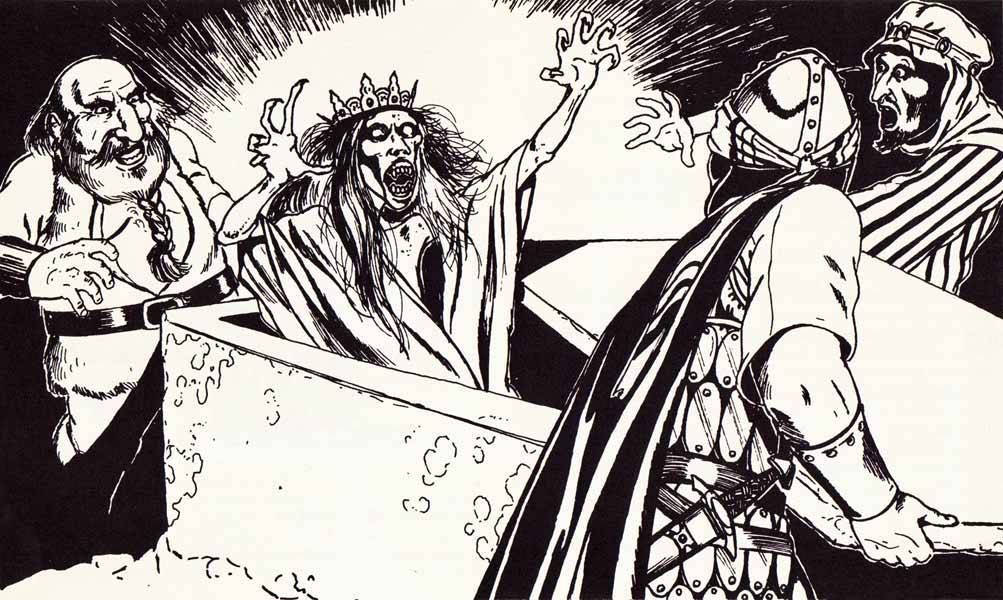
ADQ: Can non-corporeal undead fly,
or
are they affected by gravity like most
other creatures?
ADA: Non-corporeal undead can fly
only if
a flying speed is given in the creature
description.
Ghosts travel mainly on the ethereal
plane, so in their partial manifestations
they can appear to float or fly as desired,
except when they have assumed material
form.
Note that due to format
Changes, certain
bits of data in the original MM
book are incompletely (and sometimes
incorrectly) presented, using the modern
viewpoint. A Spectre, for example, has
Maneuverability Class B, which is not in
the book. A giant gar's movement rate is
not 30", as given; it's 0"//30", since
it can't
walk around on land.
(Polyhedron #30)
richardstincer wrote:
Thanks for for your reply,
Gary. I have always had trouble with reading comprehension and quick learning.
For ADandD 1st edit., can there be a TN-alignment undead character, creature,
person, or humanoid? I'm thinking that positive energy and negative energy
can both be used to animate the dead. Also, the state of undeath has a
balance of life and death at the same time, so should that allow a TN-alignment
undead?

No problem, Richard. I have
trouble with higher mathmatics 8O
The short answer is no.
All undead are of negative
plane energy, and can not be of neutrality.
Cheers,
Gary
Solomoriah wrote:
Col_Pladoh wrote:
Quote:
Does every undead have a
spirit/soul bound to it?
No soul but the assumption is that some form of malign spirit or spirit force motivates the undead creature.
Aha! So I was right!
... it happens so rarely,
i must write it on my calendar ...

In your campaign you are
always right 8)
anyway, the undead are all motivated by something non-corporeal, whether their own evil spirit that lingers or some malign spirit entity that has possessed the remains.
Cheers,
Gary
Gandalf Istari wrote:
Col_Pladoh wrote:
Would this include undead
created via an animate dead spell, such as skeletons and zombies? It's
been asserted that you always held undead such as skeletons and zombies
to be nothing more than automatons, powered by magical force with no "spirit
possessing the remains" as you put it.
Thanks in advance for any
clarification.

Not that any of this matters
a jot or tiddle, but...
Right you are about mindless skeletons and zombies. They operate as golems, by magical energy, although some malign intellect might direct them. Animated dead are not akin to the true undead--ghouls and wights and the rest.
This is not to say thet a malign spirit could not possess a skeleton or a corpse, so as to make something more potent and dangerous than the usual. the juju zombie was an example of such a concept, and skeleton "lords" are likewise.
Cheers,
Gary
Richard wrote:
Thanks, Gary. What about
arcane magic or the undead state as an unnatural TN-alignment force for
ADandD 1st edition? Arcane magic seems to be more disruptive and showy
than divine magic. It seems like Boccob's religion or a religion-portfolio
that has the undead state as its main theme is exactly the TN-alignment
opposite-of-nature religion-portfolio that is the antithesis to druid-nature
and druid-neutral.

Pray what sort of crap is
"arcane magic"? In truth, who can deny that ALL magic is arcane. What stuff...
The undead use magic of human sort as perverted by the negative force of the evil of the nether planes, or at best the generally malign nagativity of the shadow plane.
I have nothing more to offer ![]()
Cheers,
Gary
Quote:
Originally posted by Geoffrey
Gary, what are your thoughts
on non-human undead?
I for one think they strike
a discordant note.
Kobold vampires, halfling
mummies, gnomish wraiths, etc. all seem ridiculous to me rather than fantastical.

Non-human undead of the skeleton
and zombie sort are fine.
Others of the class might
be possible too.
The main objection is that
some few members subsume possession of a soul.
this is a matter of personal
taste, IMO.
If you dislike having such
undead in the campaigm, then exclude them, and you are not wrong.
Cheers,
Gary
Quote:
Originally posted by optimizer
Howdy!
I can see having nonintelligent
undead from any race - it makes some nice variations on the monster. ![]()
Based upon what you said, then it is the presence of a soul that permits the existance of higher-level undead. So would it be correct to assume that any creature that one could use a Raise Dead spell on can also be turned into a higher-level undead? Then those without souls would have to be a different but related type of undead (if desired) - such as an elven wraith-kin as an example. Would that work from a game perspective?
Thanks!
Mike

Hola Mike!
The test of Raise Dead would be a fine measure of what sorts of non-human can be undead of standart sort for humans.
As I recall, though, there is some inconsistancy in regards characters being Reincarnated as a race that is soul-less <frown> Now I think of it, eh?
Heh,
Gary
